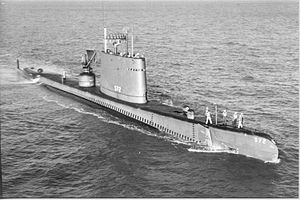 USS Sailfish (SSR-572)
| |
| Class overview | |
|---|---|
| Builders | Portsmouth Naval Shipyard, Kittery, Maine |
| Operators | |
| Built | 1953–1956 |
| In commission | 1956–1978 |
| Planned | 2 |
| Completed | 2 |
| Retired | 2 |
| General characteristics | |
| Type | Radar picket submarine |
| Displacement | |
| Length | 350 ft 6 in (106.83 m) |
| Beam | 29 ft 1 in (8.86 m) |
| Draft | 16 ft 4 in (5 m) |
| Propulsion |
|
| Speed |
|
| Complement | 95 officers and men |
| Armament |
|
The Sailfish-class submarines of the United States Navy, launched in 1955–1956, were the first submarines to be built expressly for radar picket service and, at the time, were the largest conventionally powered submarines in the United States Navy. Only USS Argonaut and the Narwhal-class submarines from the 1920s were larger. The Sailfishes were initially equipped with large BPS-2 and BPS-3 radars in and aft of the sail. They were designed under project SCB 84 for a high surface speed; however, their speed achieved was not significantly faster than converted World War II radar picket submarines.[2] Commissioned in 1956, they served in the radar picket role until early 1961, when the submarine radar picket mission ended fleetwide. Airborne radar had superseded it with the deployment of the Grumman WF-2 Tracer. Modernized under the Fleet Rehabilitation and Modernization II (FRAM II) program 1964–1966, both submarines served until decommissioning in the late 1970s.
- ^ Bauer, K. Jack; Roberts, Stephen S. (1991). Register of Ships of the U.S. Navy, 1775-1990: Major Combatants. Westport, Connecticut: Greenwood Press. p. 291. ISBN 0-313-26202-0.
- ^ a b c Friedman, Norman (1995). U.S. Submarines Through 1945: An Illustrated Design History. Annapolis, Maryland: United States Naval Institute. pp. 94–95, 242. ISBN 1-55750-263-3.